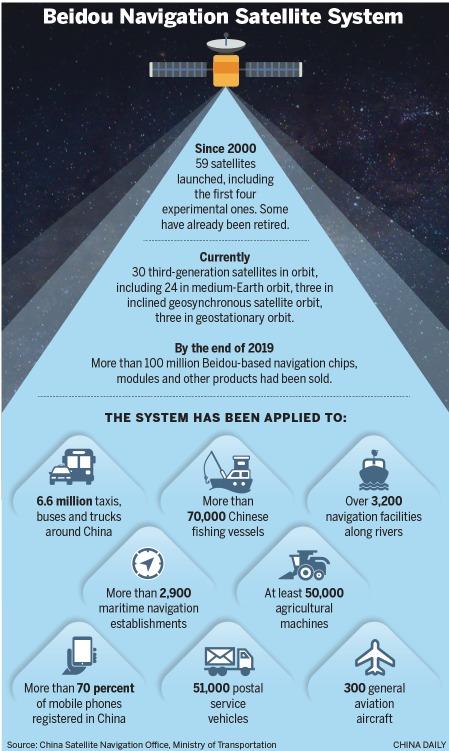 The final satellite of the Beidou Navigation Satellite System is launched and sent into orbit by a Long March 3B carrier rocket from Xichang Satellite Launch Center in Sichuan province on June 23, 2020. (YIN GANG / FOR CHINA DAILY)
The final satellite of the Beidou Navigation Satellite System is launched and sent into orbit by a Long March 3B carrier rocket from Xichang Satellite Launch Center in Sichuan province on June 23, 2020. (YIN GANG / FOR CHINA DAILY)
The final satellite to complete the third-generation network of China's Beidou Navigation Satellite System was launched on Tuesday morning, marking a milestone in the nation's space endeavor.
As the countdown ticked down to zero at 9:43 am at the Xichang Satellite Launch Center in Sichuan province, eight engines on the first stage and four boosters of a Long March 3B carrier rocket spat orange flames as they lifted the 19-story-tall vehicle and the satellite into cloudy skies.
About 30 minutes later, Zhang Xueyu, director of the Xichang center, announced at the command and control hall that the satellite, the 59th in the Beidou family and the 30th in the third-generation series, had been placed in a geostationary orbit in a normal state and the mission was a complete success.
The deployment of the satellite marked the completion of the in-orbit construction of Beidou, one of four global navigation networks, along with the United States' GPS, Russia's GLONASS and the European Union's Galileo
The launch was originally scheduled for June 16, but the mission command decided to postpone it several hours before the ignition due to a technical problem in the rocket.
The deployment of the satellite marked the completion of the in-orbit construction of Beidou, one of four global navigation networks, along with the United States' GPS, Russia's GLONASS and the European Union's Galileo.
ALSO READ: Roadmap for Beidou system application released
Dozens of medical workers from across Sichuan province who have fought against COVID-19, and Li Lanjuan, a top epidemiologist who has played a major role in China's anti-coronavirus efforts, were invited by the space authorities to witness the launch.
The launch was broadcast live by China Central Television, becoming the first Beidou mission to be on live TV and also the first televised launch at the Xichang center in a decade.
The United Nations Office for Outer Space Affairs sent a congratulatory letter on Tuesday to China's space authorities, appreciating Beidou's contribution to global economic and social development as well as the peaceful use of space and international cooperation in space.
After a period of in-orbit tests, the new satellite will begin to work with other Beidou satellites, allowing users around the globe to access high-accuracy navigation, positioning and timing services, according to the China Satellite Navigation Office.
READ MORE: Beidou system soon available worldwide
The spacecraft, which was transported by rail to the Xichang center on April 4, was designed and manufactured by the China Academy of Space Technology, a subsidiary of the State-owned space conglomerate China Aerospace Science and Technology Corp. Based on the DFH-3B satellite platform, it is designed to work in orbit for at least 12 years, according to the academy.

Since 2000, a total of 59 satellites, including the first four experimental ones, have been launched from Xichang on 44 Long March 3-series rockets, and some of them have already been retired.
Following Tuesday's launch, there are 30 third-generation Beidou satellites in three types of orbit-24 in medium-Earth orbit, three in inclined geosynchronous satellite orbit and three in geostationary orbit. There are also some second-generation Beidou satellites in operation offering regional services.
READ MORE: Beijing to beef up support for Beidou-related industry
"Compared with the second-generation satellites, the third-generation models have higher accuracy and stability, a clearer signal and more state-of-the-art technologies such as inter-satellite links, satellite-based augmentation and global emergency search capability," said Chen Zhonggui, chief designer of the third-generation satellite at the China Academy of Space Technology.
Chen said that the third generation is 10 times stronger than the second generation in terms of overall service capability.
In addition to optimized navigation and positioning capabilities, the third-generation model allows a user in areas with poor conventional communication signals to send 1,200 Chinese characters in a single message to receivers, while previous models can send only 120 characters, he added.
Beidou not only has tens of satellites but also a vast ground-based network that includes dozens of stations, more than 200 subsystems and over 30,000 sets of equipment.
More than 300,000 scientists, engineers and technicians from more than 400 domestic institutes and enterprises have been involved in Beidou's development and construction.
Beidou began providing positioning, navigation, timing and messaging services to civilian users in China and other parts of the Asia-Pacific region in December 2012. At the end of 2018, Beidou started providing global services.


